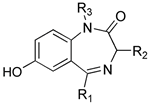Glossary of Terms Used in Combinatorial
Chemistry
[A-B]
[C] [D] [E-G]
[H-K] [L]
[M-N] [O-P] [Q] [R]
[S] [T] [U-Z]
E-G
Encoding: Strategy for pool/split
synthesis whereby a surrogate analyte is associated with each member
of a combinatorial library.
This is often achieved by the use of tags
attached to the particle of solid
support on which the library members are assembled. This allows
determination of the reaction history of an individual particle 21.
Enumeration: Conceptual process for
explicitly describing discrete members
of a library by elaborating the generic
structure together with a specified set of residues.
Fingerprint: Numerical representation
of a compound or library which describes in a computationally simple
fashion a set of attributes (descriptors)
such as atom connectivities, 3-D structure, or physical properties 29,40.
Flow Cytometry: Technique for characterizing
or separating particles such as beads or cells, usually on the basis
of their relative fluorescence 41.
Fluidic System: Device for synthesis
or screening in which fluids such as reagents or assay buffers may be
directed to specified locations by the opening and closing of valves
in a stationary network of tubes and wells. See also robotic
system 42.
Fluorous Synthesis: Approach
for solution phase synthesis which takes advantage of the ability of
highly fluorinated groups to partition out of aqueous and most organic
solutions into a third phase consisting of a fluorinated solvent. As
an example, the compound shown below (with 39 fluorines per molecule)
may be isolated by this approach. The fluorinated side-chain acts as
a soluble support for synthesis 43.

Focused Library: see Directed
Library
Frontal Affinity Chromatography:
Method for screening mixtures of compounds for affinity against an immobilised
target 44.
Fully Combinatorial : Containing,
or designed to contain, all possible combinations of building
blocks. Pool/Split libraries
are generally fully combinatorial while parallel
synthesis libraries may not be. See also reagent
efficiency.
Gel Phase: Description applied
to certain 'solid' supports which display properties intermediate between
solid and liquid phases, e.g. in the apparent mobility of the support
as determined by NMR spectroscopy 45.
Generic Structure: The general
structural formula of a library, consisting of the scaffold
plus an indication of the position of attachment of the various residues.
The diagram shows the generic structure of a 1,4-benzodiazepin-2-one
library 46.

Genetic Algorithm: Method for
library design by evaluating the fit of a parent library
to some desired property (e.g. the level of activity in a biological
assay, or the computationally-determined diversity of the compound set)
as measured by a fitness function.
The design of more optimal daughter libraries
is then carried out by a heuristic
process with similarities to genetic selection in that it employs replication,
mutation, deletions etc. over a number of generations 47-49.

